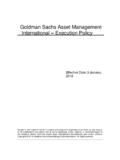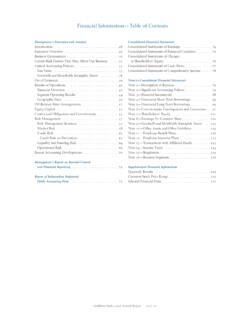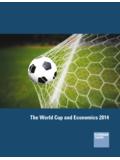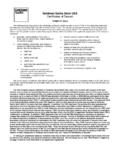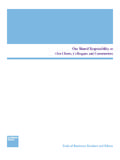Transcription of ACCELERATING TRANSITION
1 ACCELERATING TRANSITIONTASK FORCE ON CLIMATE-RELATED FINANCIAL DISCLOSURES REPORT 2021I. INTRODUCTION PAGE 02A Letter from our CEODAVID SOLOMON CHAIRMAN AND CHIEF EXECUTIVE OFFICERAs a financial institution, we believe we can achieve the greatest impact in advancing the climate TRANSITION by partnering with our clients across our business. Whether it s by developing new sustainability-linked financing solutions, offering world-class strategic advice, or co-investing alongside our clients in cutting-edge clean energy companies, we re constantly innovating and expanding new commercial capabilities to help our clients accelerate their build a more sustainable planet will require nothing less. Our own Carbonomics research estimates that $56 trillion in green infrastructure investments is needed worldwide to reach a net zero economy by this report we have defined a range of ambition for an initial set of industries where we see a significant opportunity to help our clients decarbonize.
2 These near-term targets reflect the aspirational goals we have for our business, clients, and the global economy. Having reliable data will be critical to measuring our impact and managing our progress toward these targets. So, we are continuing our work with corporate partners to develop a free, open-source platform for climate-related data and to equip our clients with new tools like our Carbon Portfolio Analytics in Marquee to measure their carbon impact. Building a more sustainable economy is a global effort, and we re firmly committed to do our part but even still, we will not succeed unless we approach the problem with global solutions. The public and private sector must work together. It s especially important for financial institutions to direct capital to sustainable solutions in emerging markets, where the climate TRANSITION faces a more daunting journey. That s why we ve partnered with Bloomberg Philanthropies to launch a Climate Innovation Fund that will encourage public and private investment in clean energy projects across South and Southeast Asia.
3 Beyond these efforts, we also need thoughtful public policy that strikes a balance between current energy capabilities and support for new technology, as well as concrete measures, like a price on carbon, that will accelerate a just and orderly TRANSITION . Because in the end that s what this is: a TRANSITION . It s going to take time. But as this year s report shows, we re making progress, a more sustainable future is within reach, and Goldman Sachs is determined to do our part to help the world get INTRODUCTION PAGE 03WE ACHIEVE THIS through OUR FIRMHOW WE DO ITOUR WORK WITH CLIENTSWHAT WE DOOUR PARTNERSHIPS, ENGAGEMENT & IMPACTHOW WE ADDRESS GAPSCLEAN ENERGYSUSTAINABLE TRANSPORTECOSYSTEM SERVICESWASTE & MATERIALSSUSTAINABLE FOOD & AGRICULTUREACCESSIBLE & INNOVATIVE HEALTHCAREACCESSIBLE & AFFORDABLE EDUCATIONFINANCIAL INCLUSIONCOMMUNITIESADVANCING THE CLIMATE TRANSITIONDRIVING INCLUSIVE GROWTHWe advance sustainable economic growth and financial opportunityOUR PURPOSEG oldman Sachs has a long-standing commitment to address the impacts of climate change and accelerate the TRANSITION to a low-carbon economy we were one of the first major banks to acknowledge the scale and urgency of climate change in 2005.
4 Since then, we have accelerated our efforts to integrate sustainability across our business, prioritizing climate TRANSITION and inclusive growth in our commercial efforts with & enableManageAddress financing, policy, data & knowledge gapsour clients climate transitions through innovative commercial capabilities and productsin the broader ecosystem and drive greater impact through strategic partnershipsclimate-related risk for our own business, supported by robust governance and policiesI. INTRODUCTION PAGE 04 Expanding our commercial capabilities to help our clients measure and manage their climate-related exposure, such as: a new cross-firm initiative to support our corporate clients on their decarbonization strategies the recently launched Carbon Portfolio Analytics in our cross-asset digital client services platform, Marquee a holistic ESG client advisory model with a climate segment Developing new financing tools that are tied to progress on climate TRANSITION , such as bonds linked to related key performance indicators Investing in climate solutions and emerging technologies that will be critical to enabling decarbonization in the hardest-to-abate sectorsAs a financial institution, we believe the most meaningful role we can play in the global climate TRANSITION is to drive decarbonization in the real economy in partnership with our clients.
5 We see significant opportunities in further mobilizing the full breadth of our business and franchise to support this effort. These include:We have also built a dynamic model to engage our clients on climate TRANSITION that leverages the breadth of resources and capabilities across our business. It is grounded in our commercial work with clients and catalyzed by our ten-year, $750 billion commitment to sustainable finance. These efforts are further strengthened by strategic partnerships we have established in areas where we have identified gaps, or believe are able to drive even greater impact through collaboration. This includes our work as the founding US bank member of OS-Climate, an open-source platform for climate data and analytical tools that will be critical for our clients to achieve their net zero ambitions. It also includes our climate finance partnership with Bloomberg, where we launched a Climate Innovation Fund alongside Bloomberg Philanthropies and the Asian Development Bank to provide essential de-risking capital for low-carbon economic development in South and Southeast Asia, a region that will play a critical role in the global climate INTRODUCTION PAGE 05In March 2021, we announced our commitment to align our financing activities with a net zero by 2050 pathway.
6 In this TCFD report, we share an initial set of targets for 2030, focused on sectors where we see an opportunity to proactively engage our clients, deploy capital, and invest in new commercial solutions. In a report we helped to inform with the Global Financial Markets Association (GFMA) that was published last year, it is estimated that $100 $150 trillion in investment is needed globally in the highest emitting sectors over the next three decades to TRANSITION to a low-carbon economy, demonstrating the critical role that capital markets can play to support and accelerate TRANSITION in the years ahead. Our initial set of targets for 2030 demonstrate our continued commitment to deliver on the goals of the Paris Agreement, and represent sectors of the economy where we believe companies will need massive support through capital and strategic advice to deliver on net zero public policy and technological advancement will be critical for financial institutions to effectively engage corporates in these sectors in TRANSITION and invest in new solutions.
7 Further, ACCELERATING policy action will be a key determinant in driving the pace at which we and our clients can achieve decarbonization goals across sectors and geographies. Achieving a just, orderly TRANSITION will require a collaborative, whole-of-society approach that includes contributions from both the public and private sectors. In our second Task Force on Climate-related Financial Disclosures (TCFD) report, we share an interim roadmap for how we plan to deliver on our commitment to align with a net zero by 2050 pathway. We describe the significant work we have already undertaken to drive low-carbon TRANSITION efforts for our clients through the development of new commercial capabilities and innovative climate solutions. We also acknowledge that in addition to unprecedented opportunities, the effects of climate change present risks that have the potential to impact our business in a variety of ways.
8 As a global financial institution, we are continuously assessing and managing the risks posed by climate change to our business through proprietary models that leverage the latest science and industry best practices on stress testing, and are further integrating climate into our firmwide business and risk practices more broadly. OUR CLIMATE JOURNEYI. INTRODUCTIONPAGE 06 One of the first US banks to develop an Environmental Policy FrameworkInaugural clean energy financing and investment target setFirst of our peers in the financial services sector to reach carbon neutrality in our operations and business travel; set new 5-year operational impact goals for 2020 Launched GS SUSTAIN, which incorporates ESG criteria into the fundamental analysis of companies to identify long-term outperformersExpanded green bond market involved in first century (100-year maturity) green bond, first green energy market securitization, first Latin America renewable project green bond20072012201420152019202020212005 FEBRUARY Joined OS-Climate initiative as the US founding bank memberIssued $800 million inaugural Goldman Sachs sustainability bondMARCHA nnounced net zero by 2050 pathway commitment.
9 Expanded operational carbon commitment to become net zero by 2030 in our operations and supply chainJoined UN Principles for Responsible BankingAPRIL Launched $200 million Restore Fund in partnership with Apple and Conservation International (CI)Announced Goldman Sachs Bloomberg Climate Finance Partnership, including a Climate Innovation Fund alongside the Asian Development BankOCTOBER Joined Net Zero Banking AllianceNOVEMBERJ oined Forest Investor Club as a Founding Member, led by The Special Presidential Envoy for ClimateLaunched Carbon Portfolio Analytics for clients in MarqueeDECEMBER Published second TCFD report, including interim roadmap for net zero by 2050 commitmentSpearheaded cross-firm decarbonization offeringAPRILP ublished inaugural TCFD reportJULYP artnered with Rocky Mountain Institute on the launch of the Center for Climate-Aligned Finance DECEMBERGFMA Climate Finance Markets and the Real Economy ReportJULYE stablished our Sustainable Finance GroupDECEMBERA nnounced $750 billion sustainable finance commitment by 2030.
10 Set 2025 operational goalsDECEMBERL aunched Carbonomics, our flagship research seriesSECTION IIGovernanceAddressing climate change is a core area of focus for our business, spanning our work with clients and counterparties, and how we manage risk. As such, we integrate oversight of climate-related risks into our firm s centralized governance structures, from senior management to our Board of Directors. At the highest level, our Board of Directors oversees the management of the firm s most significant risks, including climate-related risks. We have also established dedicated sustainability councils within each of our business divisions responsible for delivering on ESG-related priorities, including for those related to climate. This year, we established a new Firmwide Climate Steering Group, which provides oversight and guidance on the firm s approach to managing climate-related risks and opportunities, including our net zero by 2050 pathway commitment.


